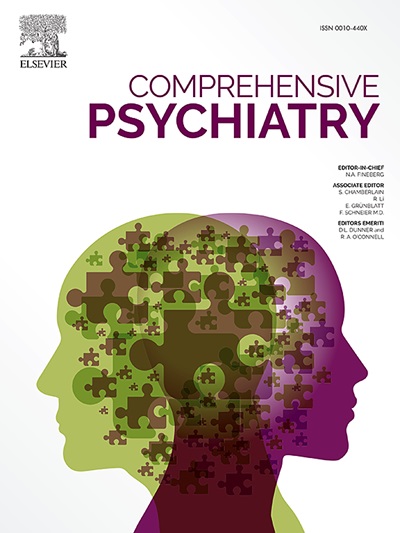Mapping psychiatric comorbidity network: A pilot multi-method weighted network analysis with a focus on key disorders
IF 4.2
2区 医学
Q1 PSYCHIATRY
引用次数: 0
Abstract
Background
Psychiatric comorbidity is a prevalent phenomenon that imposes a significant burden on patients, healthcare systems, and society. However, current research on psychiatric comorbidity is often limited to single disorders or partial associations. This study aims to utilize network analysis methods to construct a psychiatric comorbidity network and explore the network structural characteristics under different network weight definitions.
Method
Based on the psychiatric outpatient data from Changhua Christian Hospital in Taiwan from January 1, 2016, to June 30, 2024, the ICD-10 diagnostic codes (F00-F99) of all patients that appeared at least three times were extracted. Three different comorbidity networks were constructed using co-occurrence counts, Jaccard index, and partial correlation coefficient estimated by the mixed graphical model (MGM) as the weights of the network edges. Network structure was analyzed using indicators such as degree centrality, modularity, and community detection.
Results
The dataset included 16,954 patients. The comorbidity frequency network showed that mood disorders (F34) and anxiety disorders (F41) had the highest weighted degree centrality. In the Jaccard coefficient network, the weighted degree centrality of developmental disorders (F8x) increased. The MGM network highlighted the central role of substance use disorders (F1x).
Conclusion
Our findings suggested the roles and interrelationships of different disease categories in the comorbidity network. The results provide new perspectives and data support for clinical practice and future research.
映射精神共病网络:一个试点多方法加权网络分析与重点疾病
精神疾病共病是一种普遍现象,给患者、卫生保健系统和社会带来了沉重的负担。然而,目前对精神疾病共病的研究往往局限于单一疾病或部分关联。本研究旨在运用网络分析方法构建精神共病网络,探讨不同网络权重定义下的网络结构特征。方法根据台湾彰化基督教医院2016年1月1日至2024年6月30日的精神科门诊资料,提取出现至少3次的所有患者的ICD-10诊断码(F00-F99)。利用共现数、Jaccard指数和由混合图形模型(MGM)估计的偏相关系数作为网络边的权值,构建了三种不同的共病网络。使用度中心性、模块化和社区检测等指标分析网络结构。结果数据集包括16,954例患者。共病频率网络显示,情绪障碍(F34)和焦虑障碍(F41)的加权度中心性最高。在Jaccard系数网络中,发育障碍的加权度中心性(F8x)增加。米高梅网络强调了物质使用障碍的核心作用(F1x)。结论不同疾病类型在合并症网络中的作用和相互关系。研究结果为临床实践和今后的研究提供了新的视角和数据支持。
本文章由计算机程序翻译,如有差异,请以英文原文为准。
求助全文
约1分钟内获得全文
求助全文
来源期刊

Comprehensive psychiatry
医学-精神病学
CiteScore
12.50
自引率
1.40%
发文量
64
审稿时长
29 days
期刊介绍:
"Comprehensive Psychiatry" is an open access, peer-reviewed journal dedicated to the field of psychiatry and mental health. Its primary mission is to share the latest advancements in knowledge to enhance patient care and deepen the understanding of mental illnesses. The journal is supported by a diverse team of international editors and peer reviewers, ensuring the publication of high-quality research with a strong focus on clinical relevance and the implications for psychopathology.
"Comprehensive Psychiatry" encourages authors to present their research in an accessible manner, facilitating engagement with clinicians, policymakers, and the broader public. By embracing an open access policy, the journal aims to maximize the global impact of its content, making it readily available to a wide audience and fostering scientific collaboration and public awareness beyond the traditional academic community. This approach is designed to promote a more inclusive and informed dialogue on mental health, contributing to the overall progress in the field.
 求助内容:
求助内容: 应助结果提醒方式:
应助结果提醒方式:


